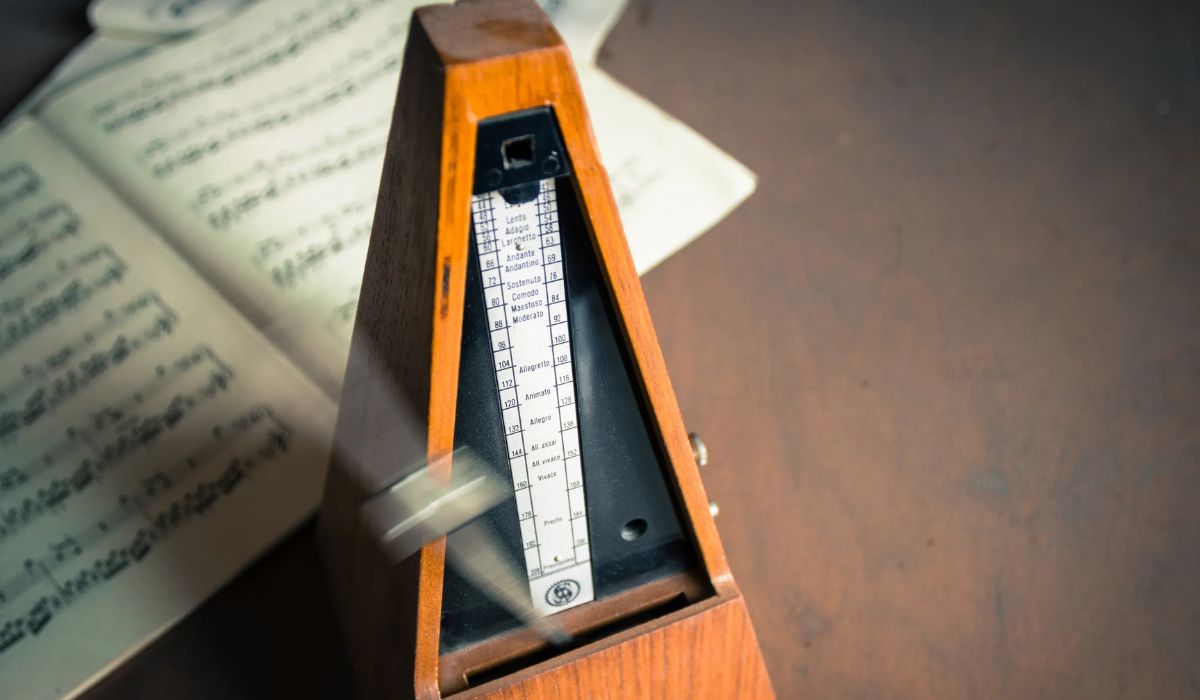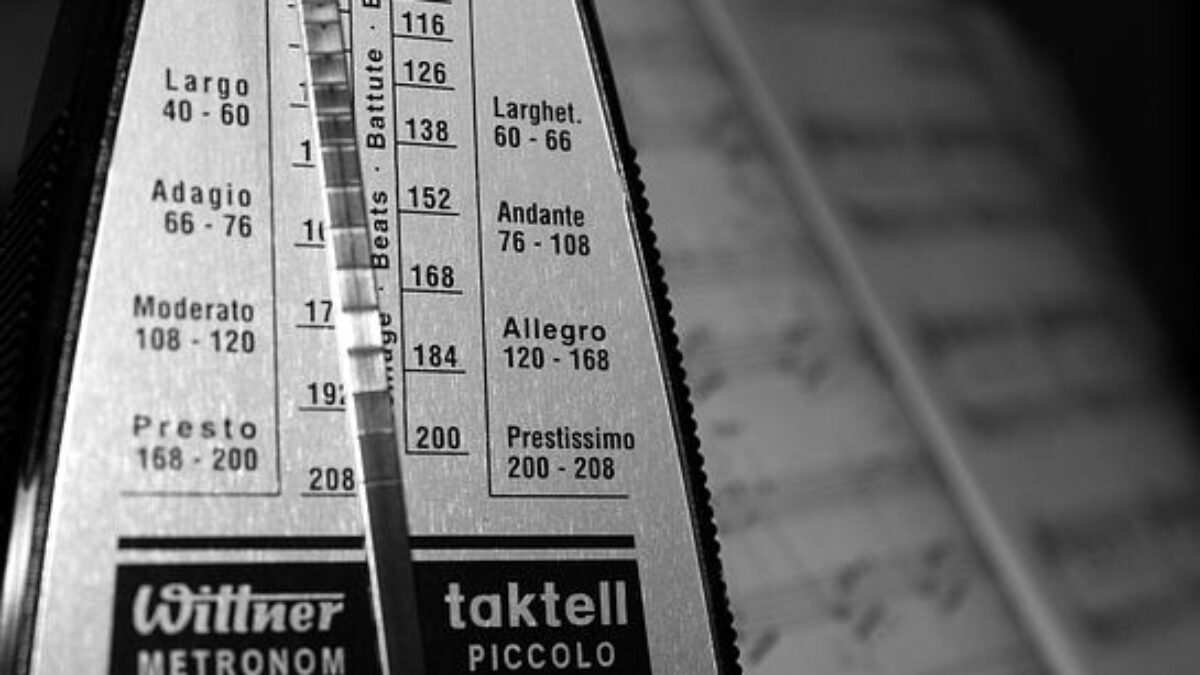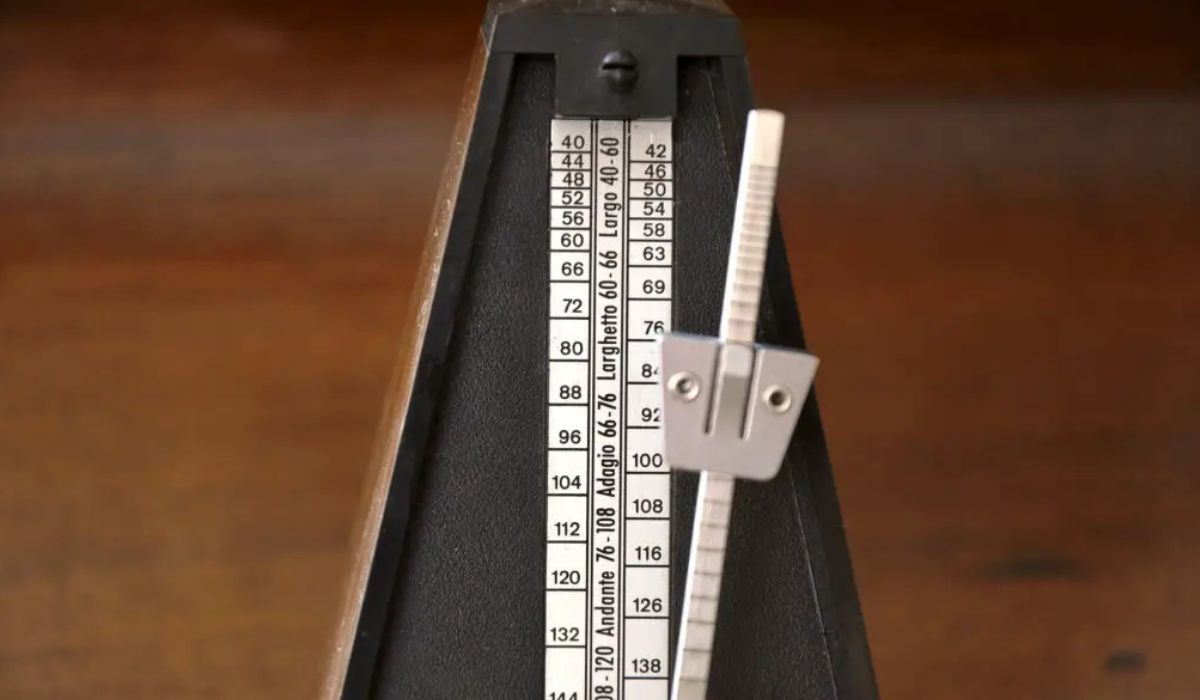Home>Production & Technology>Metronome>How To Play Metal Metronome


Metronome
How To Play Metal Metronome
Published: January 13, 2024
Learn how to play metal guitar with a metronome and improve your timing, speed, and precision. Master the art of playing to a steady rhythm with our step-by-step guide.
(Many of the links in this article redirect to a specific reviewed product. Your purchase of these products through affiliate links helps to generate commission for AudioLover.com, at no extra cost. Learn more)
Table of Contents
Introduction
Welcome to the world of metal music! Playing metal requires precision, speed, and a strong sense of rhythm. And one of the best tools to improve your timing and keep your playing tight is a metronome. A metronome is a device that produces a steady click or beep at a specific tempo, helping musicians stay in time and develop a solid internal rhythm.
In this article, we will guide you through the steps of using a metronome to play metal music. Whether you’re a beginner or an experienced guitarist or drummer, the tips and techniques discussed here will help you level up your metal playing skills.
Why is using a metronome so important in metal music? Metal is known for its fast and complex rhythms, intricate double bass pedal work, and syncopated patterns. To execute these elements accurately and with precision, you need to develop a strong sense of timing and rhythmic stability. By practicing with a metronome, you can train yourself to play with impeccable timing, allowing you to play fast and tight.
Playing along with a metronome also has the added benefit of improving your overall musicianship. It can enhance your ability to stay in sync with other band members, make your performance more consistent, and help you internalize complex rhythms. So, let’s jump into the world of metal metronome playing and unleash your metal prowess!
Step 1: Choosing a Metronome
The first step in playing metal with a metronome is to choose the right metronome for your needs. There are several options available, ranging from traditional mechanical metronomes to modern digital ones. Here are a few factors to consider when selecting a metronome:
- Accuracy: Look for a metronome that offers precise and consistent timing. Digital metronomes tend to be more accurate than mechanical ones.
- Tempo Range: Check the metronome’s tempo range to ensure it covers the speeds required for metal music. Look for a metronome that can handle both slow and fast tempos.
- Sound Options: Consider the different sound options available. Many metronomes offer various tones and beats, allowing you to choose the sound that best suits your playing style.
- Visual Display: Some digital metronomes come with a visual display that shows the beat, making it easier to follow along.
- Portability: If you plan on practicing on the go or playing live shows, opt for a compact and portable metronome that can easily fit into your gig bag.
Once you’ve chosen your metronome, familiarize yourself with its features and controls. Experiment with different sounds, tempos, and visual displays to find the settings that work best for you. Understanding how to operate your metronome effectively will greatly enhance your practice sessions.
Remember, the goal is to find a metronome that suits your preferences and helps you stay in rhythm. Experiment with different options until you discover the perfect metronome for your metal playing.
Step 2: Setting the Tempo
Setting the tempo is a crucial step in using a metronome to play metal music. The tempo, measured in beats per minute (BPM), determines the speed at which you play. In metal, tempos can range from slow and heavy to blisteringly fast.
To set the tempo on your metronome, start by determining the desired BPM for the piece or exercise you’re practicing. If you’re a beginner, it’s advisable to start with a slower tempo and gradually increase the speed as you become more comfortable.
Here are a few strategies for setting the tempo:
- Tap Out the Beat: If you’re unsure of the exact tempo, use the tap feature on your metronome. Simply tap along with the music or the rhythm you want to practice, and the metronome will match its tempo.
- Refer to Sheet Music: If you’re playing a piece of music, check the sheet music for the indicated tempo marking. It may specify the tempo as a specific BPM or using descriptive terms like “allegro” or “presto.”
- Listen to the Original Recording: If you’re learning a metal song from a recording, listen carefully to the original track and try to match its tempo using the metronome.
Once you’ve determined the desired tempo, set it on your metronome. Some metronomes have a dial or buttons to adjust the BPM directly, while others require you to input the value manually.
Remember, practicing at different tempos is important for developing your versatility as a metal musician. Experiment with playing the same piece at different speeds to improve your control over different tempos. By mastering playing at slower tempos, you’ll build a solid foundation for tackling faster and more challenging metal music.
Step 3: Practicing Basic Rhythms
Now that you have your metronome set at the desired tempo, it’s time to begin practicing basic rhythms. This step is crucial for building a strong foundation in metal music and developing your sense of timing and accuracy.
Start by selecting a simple rhythm or pattern, such as eighth notes or quarter notes. Play along with the metronome, ensuring that each note aligns precisely with the click or beep. Focus on playing each note cleanly and consistently, paying attention to both your picking technique and fretting hand positioning.
Here are a few tips for practicing basic rhythms with a metronome:
- Start Slow: Begin at a comfortable tempo where you can play the rhythm accurately. As you become more comfortable, gradually increase the speed to challenge yourself.
- Count along: Mentally count the beats and subdivisions as you play. This helps you internalize the rhythm and reinforces your ability to stay in time.
- Focus on Accuracy: Pay close attention to your timing and strive for precision. It’s better to play the rhythm accurately at a slower tempo than to rush and sacrifice accuracy.
- Practice with Variations: Once you’ve mastered a basic rhythm, experiment with different variations. Try playing the rhythm in different subdivisions, accents, or palm-muted patterns to add complexity and diversity to your playing.
Consistency and accuracy are key in metal music, so make sure to practice these basic rhythms until you can play them effortlessly with the metronome. Use this time to refine your technique and develop a strong sense of rhythm. As you progress, you can gradually increase the complexity of the rhythms and challenge yourself even further.
Remember, practicing basic rhythms with a metronome is the foundation for playing more intricate and faster metal patterns. Take the time to master these fundamental rhythms, and you’ll build a solid base to tackle more advanced techniques in the future.
Step 4: Incorporating Double Bass Pedal
One of the defining elements of metal music is the use of the double bass pedal, which adds power and speed to the drumming. If you’re a drummer, learning how to incorporate the double bass pedal effectively can take your metal playing to the next level. Here’s how to practice with a metronome:
1. Start at a slow tempo: Begin by setting the metronome at a comfortable tempo where you can execute the double bass pedal technique accurately. It’s crucial to start slow to develop clean and controlled pedal strokes.
2. Focus on coordination: The key to mastering the double bass pedal is coordination between your hands and feet. Start by practicing basic patterns, such as alternating eighth notes or sixteenth notes between the bass drum and hi-hat. Use the metronome to ensure that both limbs align perfectly with the tempo.
3. Increase speed gradually: Once you feel comfortable with a specific pattern, gradually increase the tempo on the metronome. Be patient and take your time to develop the necessary speed and control. It’s essential to maintain accuracy even at higher tempos.
4. Experiment with different patterns: Once you’ve developed a solid foundation, experiment with different double bass pedal patterns. Incorporate syncopation, triplet rhythms, and off-beat accents to add variety and complexity to your drumming. The metronome will keep you in time and help you stay consistent as you explore different patterns.
5. Play along with songs: To further improve your double bass pedal technique, play along with metal songs that incorporate fast and intricate drumming. Use the metronome as a guide to ensure that you’re in sync with the original tempo of the song. This will help you develop a sense of groove and the ability to lock in with a band or backing track.
Remember, practicing with a metronome is essential for mastering the double bass pedal technique. It will help you maintain control, improve coordination, and develop your speed and accuracy as you incorporate this powerful element into your metal drumming.
Step 5: Syncopated Rhythms
Syncopated rhythms are a hallmark of metal music, giving it a dynamic and groove-oriented feel. Syncopation occurs when accents are placed on weak beats or between beats, creating an offbeat or unexpected rhythm. Mastering syncopated rhythms is crucial for adding complexity and creating interesting rhythmic patterns in your metal playing. Here’s how to practice syncopated rhythms with a metronome:
1. Choose a rhythmic pattern: Start by selecting a syncopated pattern that you want to practice. This could be a series of offbeat accents, displaced accents, or complex subdivisions. Understand the rhythm and how it fits within the context of the music you’re playing.
2. Set the metronome: Set the metronome at a tempo that allows you to play the syncopated rhythm accurately. It’s important to start at a slower tempo and gradually increase the speed as you become more comfortable.
3. Focus on precision: Pay close attention to the placement of the syncopated accents against the metronome clicks. Ensure that you’re hitting the accents precisely and that the unaccented notes are evenly spaced. Use the metronome as a guide to maintain a tight and consistent rhythmic feel.
4. Experiment with variations: Once you’ve mastered a basic syncopated rhythm, experiment with variations. Try displacing the accents, shifting the emphasis to different parts of the beat, or adding additional subdivisions. This will add complexity and creativity to your playing.
5. Practice with different subdivisions: Explore how syncopated rhythms can be played with different subdivisions, such as triplets, sixteenth notes, or dotted rhythms. This will expand your rhythmic vocabulary and allow you to incorporate a wide range of syncopated patterns into your metal playing.
Remember, practicing syncopated rhythms with a metronome helps you internalize the patterns, develop precision, and build a solid sense of timing. As you become more proficient, you’ll be able to incorporate syncopation naturally into your metal riffs, creating a unique and engaging sound.
Step 6: Speed Training Techniques
Speed is a crucial aspect of metal music, and developing fast and precise playing abilities is a goal for many metal musicians. To improve your speed, there are several techniques and exercises you can practice with a metronome:
1. Start slow and build gradually: Begin by setting the metronome at a comfortable tempo where you can play a specific riff or pattern smoothly. Focus on playing with ease and accuracy at this slower tempo. Once you feel comfortable, gradually increase the speed of the metronome in small increments. The key is to build speed incrementally to avoid sacrificing technique and control.
2. Use a metronome for alternate picking: Alternate picking is a technique where you alternate between picking down and picking up strokes while playing a riff or solo. Use the metronome to practice alternate picking exercises at various tempos. Start with simpler patterns and gradually work towards more complex ones. The metronome helps you maintain a consistent rhythm and develop clean and precise picking technique.
3. Utilize metronome subdivisions: Set the metronome to a specific subdivision, such as eighth notes or sixteenth notes, and practice playing scales, arpeggios, or licks at that subdivision. This will challenge your speed and dexterity, as well as improve your ability to synchronize your playing with the metronome. Gradually increase the tempo as you become more comfortable.
4. Incorporate burst exercises: Burst exercises involve playing short bursts of rapid notes followed by pauses. Set the metronome to a challenging tempo and play a short burst of notes, making sure that each note aligns with the metronome click. Rest briefly before repeating the burst. This exercise helps develop speed and control by gradually building up your ability to execute fast passages.
5. Practice with a metronome and backing tracks: Use a metronome in conjunction with backing tracks or drum loops to simulate playing in a band setting. This will help you develop your ability to play in tight synchronization with other musicians. Experiment with different metal styles and tempos to challenge yourself and build your endurance.
Remember, speed development takes time and patience. It’s important to maintain proper technique and focus on accuracy while gradually increasing the tempo. With consistent practice and the guidance of a metronome, you can improve your speed and become a faster and more proficient metal musician.
Step 7: Playing in Odd Time Signatures
Playing in odd time signatures is a signature characteristic of progressive and technical metal genres. These time signatures deviate from the standard 4/4 timing and add complexity and uniqueness to your playing. Developing the ability to play comfortably in odd time signatures can expand your musicality and make your metal compositions more intriguing. Here’s how to practice with a metronome:
1. Understand odd time signatures: Familiarize yourself with common odd time signatures like 5/4, 7/8, or 9/8. These time signatures have an uneven number of beats per measure and can create a sense of rhythmic displacement. Analyze songs or drum patterns in odd time signatures to understand how they’re structured and how the beats are grouped within each measure.
2. Set the metronome: Set the metronome to the desired tempo and program it to match the time signature you wish to practice. For example, for 7/8 time, set the metronome to count seven beats per measure. The metronome will help you stay on track and maintain the consistent rhythm required for odd time signatures.
3. Start with simple patterns: Begin by playing simple patterns or exercises that emphasize the beats within the odd time signature. For example, in 5/4 time, practice playing accents on the downbeat (1) and then on the offbeat (4). Use the metronome as a reference to keep your playing in sync with the desired time signature.
4. Gradually increase complexity: As you become more comfortable with the basic patterns, gradually increase the complexity of your exercises. Incorporate subdivisions, syncopated accents, and polyrhythms within the odd time signature. The metronome will help you stay grounded and ensure that you maintain a steady rhythmic feel.
5. Experiment with different feels: Odd time signatures can be played with different feels, such as a straight or swung feel. Explore different rhythmic interpretations and experiment with variations to add your own unique touch to the music. Use the metronome as a guide to maintain consistency and observe how different feels and accents interact with the odd time signature.
Remember, playing in odd time signatures requires focus and a strong sense of internal timing. Regular practice with a metronome will help you develop your ability to navigate these complex rhythms and make your metal compositions more dynamic and captivating.
Conclusion
Using a metronome is an essential tool for any metal musician looking to improve their timing, precision, and overall playing abilities. By following the steps outlined in this guide, you can harness the power of the metronome to enhance your metal playing skills.
From choosing the right metronome to setting the tempo, practicing basic rhythms, incorporating double bass pedal, exploring syncopated rhythms, training for speed, and playing in odd time signatures, each step builds upon the last to strengthen your musical foundation.
Remember, mastering metal music requires patience, dedication, and consistent practice. As you work through each step, take your time to internalize the concepts and techniques, and gradually increase the difficulty as you progress. Practice with intention and precision, always using the metronome as your guide.
Moreover, don’t forget to infuse your own creative style and personality into your playing. While the metronome helps you stay in time and maintain accuracy, it is your unique interpretation and expression that truly bring the music to life.
So, grab your instrument, set up your metronome, and embark on the journey of improving your metal playing skills. With perseverance and the guidance of the metronome, you’ll unlock new levels of precision, speed, and musicality, propelling your metal playing to new heights.











